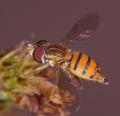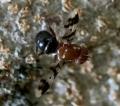Diptera.info :: Identification queries :: Diptera (adults)
Who is here? 1 guest(s)
|
Very tiny fly with stripes on thorax and eyes
|
|
| Juergen Peters |
Posted on 06-01-2007 03:46
|
|
Member Location: northwest Germany Posts: 14070 Joined: 11.09.04 |
Hello! I have no real idea, into which familiy to put this only 1-1.5 mm long fly found yesterday in our winter garden (Ostwestfalen/Germany). Any hints welcome!   
Best regards, Jürgen -=-=-=-=-=-=-=-=-=-=-=-=-=-=-=-= Juergen Peters Borgholzhausen, Germany WWW: http://insektenfo... -=-=-=-=-=-=-=-=-=-=-=-=-=-=-=-= |
| Juergen Peters |
Posted on 06-01-2007 03:48
|
|
Member Location: northwest Germany Posts: 14070 Joined: 11.09.04 |
   1024x768: http://www.foto-u..._1mm_7.jpg Best regards, Jürgen -=-=-=-=-=-=-=-=-=-=-=-=-=-=-=-= Juergen Peters Borgholzhausen, Germany WWW: http://insektenfo... -=-=-=-=-=-=-=-=-=-=-=-=-=-=-=-= |
| Gerard Pennards |
Posted on 06-01-2007 12:25
|
|
Member Location: Amersfoort Posts: 1914 Joined: 07.06.04 |
Well, I'm sure it is Ephydridae, but I'm not so familiart with the family. But I'm sure there will be others who can tell you more about it!  Greetings, Greetings, Gerard Pennards |
|
|
|
| Tony Irwin |
Posted on 06-01-2007 12:55
|
|
Member Location: Norwich, England Posts: 7282 Joined: 19.11.04 |
Hi J?rgen Gerard is right. It is Philygria (formerly Nostima) picta (Ephydridae). It is interesting that you have found it in January. Normally it is a spring and autumn species. Tony ---------- Tony Irwin |
|
|
|
| lweit |
Posted on 06-01-2007 15:55
|
|
Member Location: France, Département de la Moselle Posts: 609 Joined: 23.12.05 |
Hello Tony In Fauna Europae and other database (Funet, ....), the species Philygria picta is always named Nostima picta, subfamily : Ilytheinae, tribe : Hyadinini. In the database of AnimalDiversity Web, it belong to subfamily Parydrinae, tribe Philygriini ?? What's the true classification Thank you Louis |
|
|
|
| Juergen Peters |
Posted on 07-01-2007 00:18
|
|
Member Location: northwest Germany Posts: 14070 Joined: 11.09.04 |
Hello, Tony and Paul! Thank you very much! I see, that I learn much in this forum  . One of the possible families I had in mind was Ephydridae. But it was too vague to express it here (too afraid to blame myself again ;-)). . One of the possible families I had in mind was Ephydridae. But it was too vague to express it here (too afraid to blame myself again ;-)).Tony Irwin wrote: Gerard is right. It is Philygria (formerly Nostima) picta (Ephydridae). It is interesting that you have found it in January. Normally it is a spring and autumn species. Does it overwinter as an imago (occuring in autumn and spring does suggest that)? As I mentioned, I found it indoors in our winter garden. Best regards, Jürgen -=-=-=-=-=-=-=-=-=-=-=-=-=-=-=-= Juergen Peters Borgholzhausen, Germany WWW: http://insektenfo... -=-=-=-=-=-=-=-=-=-=-=-=-=-=-=-= |
| Paul Beuk |
Posted on 07-01-2007 09:02
|
|
Super Administrator Location: Netherlands Posts: 19403 Joined: 11.05.04 |
Juergen Peters wrote: Hello, Tony and Paul! Hehe, though I might have written something similar to what Gerard wrote, this is too much credit. 
Paul - - - - Paul Beuk on https://diptera.info |
| Tony Irwin |
Posted on 07-01-2007 13:34
|
|
Member Location: Norwich, England Posts: 7282 Joined: 19.11.04 |
lweit wrote: In Fauna Europae and other database (Funet, ....), the species Philygria picta is always named Nostima picta, subfamily : Ilytheinae, tribe : Hyadinini. In the database of AnimalDiversity Web, it belong to subfamily Parydrinae, tribe Philygriini ?? What's the true classification Well, Louis, I don't know that there is a true classification - all taxonomy (at least above species level) is artificial - and we simply choose what is most useful, or reflects our current state of knowledge. As a rule, useful classifications reflect the evolutionary history of a group, and as our understanding changes, so do classifications. Currently, the classification Ephydridae/Ilytheinae/Philygriini is favoured, though some authors include the Philygriini within the Hyadinini. Again, some authors regard Nostima as a separate genus from Philygria, but phylogenetic work published by Hollmann-Schirrmacher in 1998 appeared to show that some species of Philygria were more closely related to Nostima than to other species of Philygria. When that happens, we can either split Philygria into more genera (gets messy!) or reunite Nostima with Philygria. Further research may show that it's better to split Philygria, in which case, the name will be Nostima picta again! Tony ---------- Tony Irwin |
|
|
|
| Tony Irwin |
Posted on 07-01-2007 13:45
|
|
Member Location: Norwich, England Posts: 7282 Joined: 19.11.04 |
Juergen Peters wrote: Does it overwinter as an imago (occuring in autumn and spring does suggest that)? As I mentioned, I found it indoors in our winter garden. Yes, I think that's most likely - we know that many species of fly must overwinter as adults, though they are seldom seen in winter months - this may simply be because many dipterists are examining their summer captures, and don't go out much in winter.  Alternatively, increasing temperatures in the winter are likely to lead to unseasonal emergence of some species. I remember many years ago, that Trichoceridae was the only family I was likely to see in January. Things have certainly changed since then! 
Tony ---------- Tony Irwin |
|
|
|
| Juergen Peters |
Posted on 08-01-2007 02:21
|
|
Member Location: northwest Germany Posts: 14070 Joined: 11.09.04 |
Hello, Paul and Gerard! Paul Beuk wrote: Hehe, though I might have written something similar to what Gerard wrote, this is too much credit.  Oh, sorry!  Thanks, Gerard! I should not write postings so late in the night... Thanks, Gerard! I should not write postings so late in the night... 
Best regards, Jürgen -=-=-=-=-=-=-=-=-=-=-=-=-=-=-=-= Juergen Peters Borgholzhausen, Germany WWW: http://insektenfo... -=-=-=-=-=-=-=-=-=-=-=-=-=-=-=-= |
| Juergen Peters |
Posted on 08-01-2007 02:26
|
|
Member Location: northwest Germany Posts: 14070 Joined: 11.09.04 |
Hello, Tony! Tony Irwin wrote: lead to unseasonal emergence of some species. I remember many years ago, that Trichoceridae was the only family I was likely to see in January. Things have certainly changed since then!  Of course... I'm not sure, whether I account this to be a good thing. Yesterday a user of my forum posted an active Culiseta annulata female, photographed in Austria these days... (a species which especially loves me - had enough of them in the summer). Best regards, Jürgen -=-=-=-=-=-=-=-=-=-=-=-=-=-=-=-= Juergen Peters Borgholzhausen, Germany WWW: http://insektenfo... -=-=-=-=-=-=-=-=-=-=-=-=-=-=-=-= |
| Jump to Forum: |














